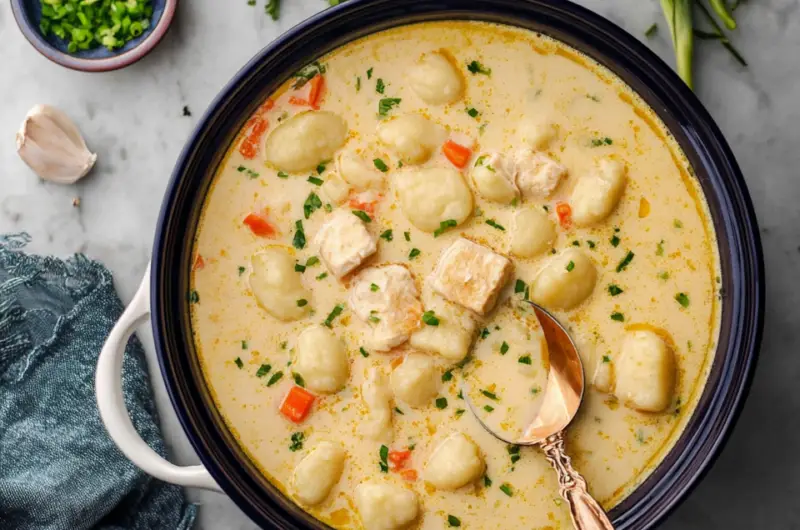The comforting essence of Knoephla Soup lies in its creamy texture, rustic roots, and homestyle flavor. This traditional German-inspired dish, popularized in the Midwest, especially North Dakota, features soft dumplings nestled in a rich, creamy potato base. The name “knoephla” refers to the dumplings themselves chewy, tender morsels that give the soup its distinct heartiness and depth. Perfect for cold evenings or when you’re craving a bowl of warmth, Knoephla Soup is more than just a meal it’s a nostalgic nod to family kitchens, communal gatherings, and age-old recipes passed down through generations. Every spoonful is a taste of comfort, simplicity, and love made visible in the form of dumplings and potatoes simmered to perfection.
Full Recipe:
Ingredients:
-
4 tablespoons unsalted butter
-
1 medium onion, chopped
-
3 cloves garlic, minced
-
4 cups diced potatoes (Yukon Gold preferred)
-
4 cups chicken broth
-
2 cups water
-
1 teaspoon salt
-
1/2 teaspoon black pepper
-
2 cups all-purpose flour
-
1 teaspoon baking powder
-
1 teaspoon salt (for dough)
-
3/4 cup milk
-
1/4 cup heavy cream
-
1/2 cup whole milk (extra, for soup base)
-
Chopped fresh parsley (optional, for garnish)
Directions:
-
In a large soup pot, melt butter over medium heat. Add chopped onion and garlic, and sauté until translucent and fragrant.
-
Add diced potatoes, chicken broth, water, salt, and pepper. Bring to a boil, then reduce heat and simmer for 10-15 minutes until potatoes are tender.
-
Meanwhile, prepare the dumplings. In a mixing bowl, combine flour, baking powder, and salt. Add milk gradually and stir until a soft dough forms.
-
On a floured surface, roll dough into thin ropes and cut into bite-sized pieces.
-
Drop the dumplings into the simmering soup and cook for 10-12 minutes, until dumplings are plump and cooked through.
-
Stir in the extra milk and heavy cream. Heat gently until warmed through.
-
Taste and adjust seasoning as needed. Garnish with chopped parsley if desired.
Prep Time: 20 minutes | Cooking Time: 30 minutes | Total Time: 50 minutes
Kcal: 390 kcal | Servings: 6 servings
Knoephla Soup: A Hearty German-American Classic for Comfort and Tradition
Knoephla Soup is more than just a cozy meal it’s a beloved cultural staple that ties together the heritage of German immigrants and the heart of Midwestern American cooking. Known for its thick, creamy texture and soft, doughy dumplings, this dish has found its way into countless homes, especially in North Dakota, South Dakota, and Minnesota, where it is often considered a symbol of warmth, tradition, and family gatherings.
Rooted in the culinary traditions of German-Russian immigrants, Knoephla Soup showcases how European flavors were adapted to American ingredients and tastes. With every bite, it evokes a nostalgic sense of place and identity, linking present-day cooks with generations of home chefs who once stirred the same creamy pot in farmhouse kitchens.
The Origins of Knoephla Soup
The word “knoephla” (pronounced NEF-lah or NEFF-lah) comes from the German word Knöpfle, which translates to “little buttons,” a fitting name for the small, round dumplings that float in this creamy soup. The dish originated with German-speaking immigrants from Russia who settled in the Dakotas in the 19th and early 20th centuries. These settlers brought with them a deep culinary tradition that was practical, hearty, and perfectly suited for the cold, long winters of the American Midwest.
Over time, the soup evolved to include readily available ingredients such as potatoes, onions, milk, and butter. The homemade dumplings, a staple of Old World cooking, remained at the heart of the dish. Knoephla Soup served as an ideal one-pot meal easy to make, filling, and nourishing for families living in rural and often harsh environments.
Cultural Significance and Popularity in the Midwest
In the Dakotas and other Midwestern states, Knoephla Soup holds a special place on dinner tables and community menus. You’ll often find it served at church potlucks, school fundraisers, and family reunions, especially during the colder months. Its rich flavor, velvety base, and fluffy dumplings make it a quintessential comfort food that brings people together.
Many families have their own treasured versions of the recipe, passed down from grandparents and great-grandparents, each with a slight variation in technique, ingredients, or seasonings. Some cooks add chicken or celery for extra flavor, while others stay strictly traditional with just potatoes, onion, cream, and dumplings. Despite the differences, one thing remains consistent: Knoephla Soup is made with love and care, a true expression of culinary heritage.
What Makes Knoephla Soup Unique?
Unlike many other creamy soups, Knoephla doesn’t rely on thickening agents like cornstarch or flour-based roux. Instead, its heartiness comes naturally from the starches in the potatoes and the dumplings themselves. The dumplings are typically made from a simple dough of flour, milk, salt, and baking powder, shaped into small pieces and simmered directly in the broth until tender.
The result is a creamy, dreamy soup that is both indulgent and grounding. The mild flavors of butter and potato are enhanced by subtle aromatics such as onion and garlic, making every bite warming and satisfying. While not spicy or bold in flavor, Knoephla Soup’s magic lies in its texture and depth rich, velvety, and full of homemade goodness.
Versatility and Customization
One of the greatest strengths of Knoephla Soup is how adaptable it is. While the traditional version features just potatoes and dumplings, modern adaptations often add ingredients to suit dietary preferences or to bulk up the nutrition content.
For instance:
-
Chicken: Adding shredded or diced chicken provides protein and a savory boost.
-
Vegetables: Carrots, celery, or corn can add texture and sweetness.
-
Broth Variations: Vegetable broth can be used in place of chicken for a vegetarian option.
-
Creaminess Level: For a lighter soup, some cooks use just milk, while others prefer heavy cream for an ultra-decadent experience.
This flexibility allows you to make the recipe your own, whether you’re cooking for a family, preparing meals in advance, or showcasing it at a dinner party. Plus, it’s a great meal prep option Knoephla Soup reheats beautifully and often tastes even better the next day as the flavors continue to meld.
Serving Suggestions
Knoephla Soup is traditionally served as a standalone meal, thanks to its richness and hearty ingredients. However, you can easily build a complete dinner around it. Here are a few serving ideas:
-
With Fresh Bread: Crusty sourdough or buttery rolls are perfect for dipping and soaking up the creamy broth.
-
Side Salad: A light green salad with a tangy vinaigrette can balance the richness of the soup.
-
Pickled Vegetables: A nod to its German roots, pickled cucumbers or beets can offer a tangy contrast.
-
Cheese Plate: For a more refined spread, pair the soup with sharp cheeses and cold cuts for a rustic, homestyle platter.
No matter how you serve it, Knoephla Soup is the kind of dish that invites slowing down and savoring—especially when shared with family or friends.
Storage and Reheating Tips
Like many soups, Knoephla only gets better with time. The dumplings absorb flavor as they rest, and the broth thickens to an even creamier consistency. Here are some storage tips:
-
Refrigeration: Store leftovers in an airtight container for up to 4 days. Reheat gently on the stove over low heat to avoid breaking down the dumplings.
-
Freezing: While possible, freezing can affect the texture of the dumplings. If freezing, consider freezing the base without dumplings, then adding fresh ones upon reheating.
-
Batch Cooking: The soup can be made in large batches and portioned out for weekly lunches or cozy dinners, making it ideal for meal prepping during colder seasons.
Health and Nutrition Insights
While Knoephla Soup is undeniably indulgent, it offers several nutritional benefits when balanced with wholesome ingredients. Potatoes provide complex carbohydrates and essential vitamins like vitamin C and potassium. Onions and garlic add antioxidants and anti-inflammatory properties, and milk or cream contributes calcium and protein.
To make the dish healthier:
-
Use low-fat milk or a milk alternative like oat or almond milk.
-
Cut back on the butter or replace it with olive oil.
-
Add leafy greens like kale or spinach for a nutrient boost.
That said, Knoephla Soup is meant to be comforting. It’s okay to enjoy the traditional version as an occasional treat that feeds both body and soul.
Conclusion:
Knoephla Soup is a timeless recipe that bridges continents, generations, and cultures. From its humble beginnings among German-Russian immigrants to its iconic status in Midwestern cuisine, this dish has earned its place as a cold-weather staple and family favorite.
Its creamy, comforting qualities make it a perfect addition to your winter meal rotation, while its simplicity and adaptability allow home cooks of any skill level to create something truly special. Whether you’re drawn to it for its nostalgic value or simply for its satisfying flavor, Knoephla Soup is a dish worth celebrating.








